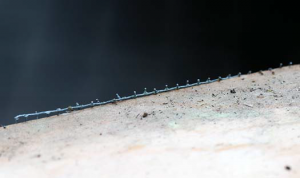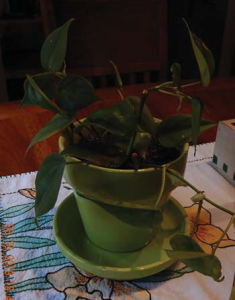By: Dr. James E. Tew
Basic beekeeping is fine
Among my many annoying characteristics, I have a particular one that especially frays my immediate family (and many others, no doubt). I will pick out a small aspect of life and harp on it. And harp on it. And harp on it. Finally, I tire of what the minor issue has been, and I move to another issue that is equally annoying.
For quite a long time, I went on and on about common redundancies in the English language. I enjoyed picking them out, but others around me quickly tired of the game. Some common ones were: (1) two halves (something halved can only be two parts), (2) hot water heater (why would you want to heat hot water?), (3) past history (all history is past), (4) ATM machine (one is saying automatic teller machine machine), and finally, (5) Tuna fish salad (tuna is fish, so the salad is simply tuna salad.). Got enough? There are hundreds more. But enough already.
Just now, I am tinkering with the word, “fine.” I’m just a bee guy, but it would seem to me that the word is presently little more than verbal filler or verbal punctuation. It’s a bit of a junk word now. We all know the actual definitions for “fine,” but absolutely everything can be fine now.
Hypothetically – Marge says, “Chuck, I’m leaving you and I’m taking everything you own.” Chuck replies, “Fine. But I will fight you forever.” Marge replies, “That’s just fine! You will never win!” In reality, neither Marge nor Chuck are fine (happy) with this situation, but somehow, fine becomes the word that is used in their responses. Just watch how often this word is whimsically used in everyday conversations or in our society.
Basic (basically) is fine’s first cousin
Another very common word that is cheap and easy to use is “basic.” Rather than present a discussion about basic as I did with fine, I want to go straight to my beekeeping thought. What is basic beekeeping? What is a basic beekeeper?
I’m asking this question for a personal reason. Here it is. After all these years, I suspect that I am, at present, simply a basic beekeeper. During other periods of my bee life, I have been several other types (stages?) of a beekeeper. Yet, according to beekeeping parlance, I was a beginning beekeeping just a bit short of 50 years ago, and here I am, at 71 years of age, yet again, a basic beekeeper. (There is room at this point for hundreds of jokes and insults. Insert the one of your choice at this juncture.)
Basic vs beginning
I see basic beekeeping as “bare bones” beekeeping. I see beginning beekeeping as the introductory stage when a new beekeeper is learning everything about the craft. What bee books are needed? What authorities have good information? What protective gear to use? How to install a package? The list could go on for pages and pages.
What the beginning person is learning is basic beekeeping. That beginning person can stay at the basic stage or, as most of new beekeepers do, they can move on to more advanced topics and interests. As these beekeepers advance, they upgrade their equipment. They explore more complex avenues of bee biology. They push their colonies to produce surplus honey, and maybe even comb honey. They are no longer beginners, but neither are they still basic beekeepers. Other than experienced beekeepers, I don’t know of a standardized name for beekeepers who have passed beyond the initial phase of beekeeping.
Jim, where is this thought going?
Basic beekeeping is not just for beginners. One could keep bees for decades and still be considered a beekeeper who keeps their colonies in simple equipment and does not buy a lot of gadgets or new hive product designs. Basic beekeeping could (theoretically) be considerably cheaper than the complex systems of managing bee colonies that so many of us use.
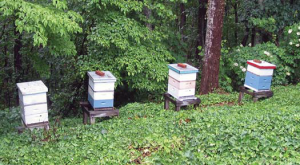
A simple but rewarding basic bee project. The bees are kept
in medium supers while deeps are used as feeder shells. The
beekeeper is an experienced keeper with years of experience.
(Thanks Frank, for the photo.)
I suspect my present concept of basic beekeeping has been brought on by all the years I have dedicated to beekeeping. I have not done everything in beekeeping, but I have come very close to covering all the main topics (Some of the stages would be queen production, pollen collecting, comb honey production, commercial beekeeping, and migratory beekeeping.) Nothing is special about my life’s bee experiences. Nearly all of us followed the same bee path.
But for me, it’s is more than that. While working for Ohio State, I had a deluxe laboratory. The lab had an extracting facility large enough to run about 1,000 colonies. Four hundred was the most we ever managed. There were three trucks one with a heavy-duty lift gate. An adjustable loading dock was in the building for unloading heavy honey. The lab had queen producing facilities – including instrumental insemination equipment. There was a large storage building for storing all the various pieces of equipment – both very old and very new. It was a great way to keep bees. Though we could teach basic beekeeping, we were certainly not basic beekeepers. None of this description is a boast. Keep reading, please.
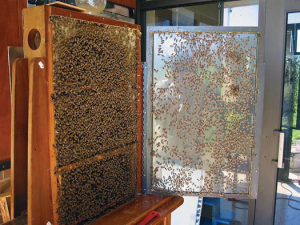
A nine-deep frame (three high and three deep) observation hive
I built many years ago. I could enjoy exploring beekeeping with
these glass hives again.
After I retired, the lab and its facilities all went away. It is the natural scheme of things. It was never mine. So, it’s probably just me, but I now find scant excitement in setting up a small extracting line after having had access to such high-level processing equipment. I don’t know what other established basic beekeepers do, but now, when I have any honey, I just have it contract extracted.
For those of you who are disappointed in my honey extracting confession, I ask you to consider the work that is required of me, working alone, to set up and perform the extracting process. Then clean it up and store it all away. I am doing this basic beekeeping for enjoyment – so much as possible. At times, even basic beekeeping is still work.
There is no standard basic beekeeper
I don’t know a definition for an experienced, but still a basic beekeeper. This type of beekeeper most likely only keeps a few colonies, but they would be most likely be kept well (or not). The hive equipment used is standard without a lot of experimental diversity. Only a single veil is needed. One smoker. A single pair of gloves are kept somewhere under the truck seat. One or two hive tools would suffice. The hive stands are probably improvised, but not necessarily. If there is an extractor, it is small and portable. An electrically heated knife would be a deluxe purchase, but it could probably be justified. Buying expensive replacement queens may or may not happen. That would be the basic beekeeper’s call. This beekeeper must have a sensible but simplistic method of mite control. The beekeeper may or may not be a swarm chaser. If colony numbers increased over time, the basic, but experienced beekeeper would likely be forced to move from the “basic” category. No, I do not see such a person as necessarily a hobby beekeeper.
“Jim, it sounds as though you are describing boring beekeeping rather than basic beekeeping.”
Let me offer a defense of the value of simple beekeeping – but not boring beekeeping.
(1) I have had a wonderful time during my beekeeping life. I’ve never been bored. I listed some of the beekeeping stages above that have kept me challenged over the years. Now, I keep up with the issues and the evolution of those issues, but I don’t have a strong desire to return to them at this point in my life. (But anything can change.) At this point, I want my bees for academic enjoyment and photo/video work. Bees and grandchildren are my two common photographic subjects. At this point, rather than spending significant sums of money on bees, I spend significant amounts of money on photographic equipment that I use to photograph my bees. It’s just the current phase I’m in. I don’t know what the next phase will be, but I can say that as my neighborhood becomes more congested, I have a growing curiosity about returning to an earlier interest I had in beekeeping – large observation hives.
(2) In urban/suburban settings, a beekeeper may be restricted in what can be done with bees in a close neighborhood. This bee operation may be more of a hobby – like bird feeding, but none-the-less stimulating.
(3) For most of us, our bees become one of the primary focuses of our lives. It could be a bit of a surprise, but some beekeepers want their bee life balanced with their gardening life or their natural history life. For them, beekeeping is part of life’s reason, and is blended with other endeavors. For many of us, beekeeping is the full thing – power beekeeping – aggressive beekeeping – knowing all we can know about bees. There’s nothing wrong with that. Some others are happy with a downsized version of those goals.
I have belabored the point of my thought. In my opinion, it is “fine” to be a basic beekeeper who has considerable experience and knowledge but does not need all the extras that the rest of us require. They keep their bees simplistically.
Screened bottom boards
Occasionally, Editor Kim, asks me for responses to various beekeeping questions that have come his way. Currently, he publishes some of my responses and responses of many other experienced beekeepers and writers in the monthly column, “Beetalk”. Recently, a questioner was asking about the practicality of screen bottom boards. I wrote a response to this query, but I simply forgot to submit it.
But in light of my comments above about basic beekeeping, I did have an interest in Dan’s question. Rare, for me, I have developed an opinion about screen bottom boards.
Question – What do you, the experts in the field, think of screened bottom boards for Langstroth hives? Do you use them on your own hives? Dan from Southern California
From Jim. Early on, I got on board with screened bottom boards. Anything that would help kill mites was good. Time passed and I cooled.
(1) Screened bottoms tend to be rather lightweight beneath a heavy hive.
(2) When using a hand truck, I have had issues with torn screens when relocating colonies in hives with such bottoms.
(3) On a couple of occasions, swarms, from where I know not, have positioned themselves beneath the bottom screen. To remove the swarm, I had to completely disassemble the hive – all the way to the bottom board, while unintentionally mixing colony bees with swarm bees. I call this “Chaotic Beekeeping.
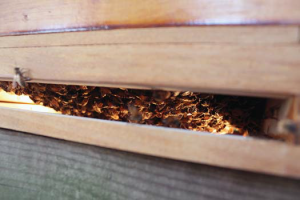
A swarm on the bottom of a screened bottom board. The hive
must be completely disassembled to get to it.
(4) To protect the wire bottom, this bottom board should be “laid” on the truck while a regular bottom board can be tossed onto the truck. The screen strength varies between bottom board manufacturers. Some take real world handling better than others.
(5) Yes, they are very useful when taking a mite count, but I have other ways for doing that task.
(6) No harm in using them, but no harm in not using them either.
That was to be my response for Editor Kim’s use – but now even more
The six points listed above was to be my concise opinion, but I feel my response needs more. Screen bottom boards are not all bad. I’m just making it sound that way.
(1) If you are established beekeeper who rarely moves your hives, this bottom board style works well. If the metal sheet used to close the bottom entrance for Winter seasons or for mite counts is used regularly, it, too, works well. If it is not used regularly, ladder combs and propolis can make the metal sheet hard to remove and reinsert. If metal sheets become mixed with metal sheets from different manufacturers, putting them into the bottom board slot can be troublesome. This issue could be resolved by using screen bottom boards from only one producer. Some producers do not even use metal, but corrugated plastic.
(2) I suspect that screen bottom boards on a hive stand help the colony stay cool on high temperature days. I have no science to support my notion.
I simply prefer a substantial reversible bottom board. Am I just being old-fashioned? Due to eagerness for screened boards, I presently have more screen bottom boards than solid ones. Over time, as I slowly replace any of my hive bottoms, I will go back to solid bottoms – either wood or plastic, but that’s just me.
I moved bee hives – again
Once again, I had to recently move eight beehives. In the near future, I will need to move them back. During past months, I have written about all my personal issues. Kim and I even produced a video showing the disruption, changes to my apiary, and some insurance concerns that I will have in the near future. I have thoroughly worn those topics out.
Even so, I just mentioned that screened bottom boards probably help cool a colony within a hive on a hot day. I have personal experience overheating bees in closed hives. I like to ventilate my moving hives in any way possible.
I put eight-mesh screen cloth on top of an empty deep. I staple the screen in place and cut it to size with tin snips. It’s a neat and clean procedure – except for all those tiny metal ends that shred my hands and constantly snag on my breathable bee suit. Folding a part of the freshly cut edges under to present an uncut edge would help, but that would still snag too much. Maybe I could fold edges in and staple from the inside. Then it begins to be work.
What do you use to screen off hive tops when moving your colonies? No matter what you use, know this – you will never get them all in and of the bees you get into the colony, some will find a way out. All you’re trying to do is to keep as many as possible inside and never, never let the bees be without abundant ventilation.
As usual,
As usual, thanks to you who could hang on during my tirade this month. No matter how my piece reads, I always enjoy beekeeping and will continue tinkering with bees indefinitely. I hope you do, too.







